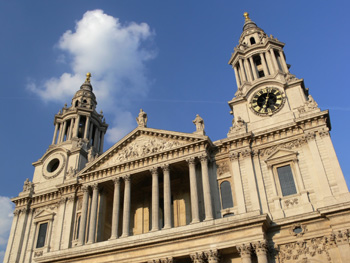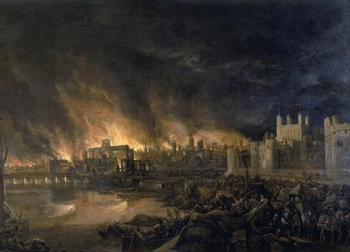Fire Extinguisher : 101
Examining the Great Fire of London
| Home |
| About Fire Extinguishers |
| Using a Fire Extinguisher |
| Fire Prevention |
| Fire Hazards |
| First Aid for Fire |
| Financial Protection |
| Biggest Fires in History |
| Firefighters |
This site was voted:

by onlinefiresciencedegree.org
(scroll to 74 on the list)
This page is intended to provide information pertaining to the great fire of London. |
Just past midnight on Sunday, September 2, 1666, one of the biggest fires in history broke out in a baker’s shop on Pudding Lane in London, England, one block north of London Bridge. This location was in the thick of the medieval city’s streets. Homes sandwiched together and constructed mainly of dry and brittle wood caught fire, rendering many people homeless and downhearted in this section of Britain’s capital city.
|
|
 London - today |
The family living above the bakery escaped through the windows, although a maidservant became the first of the surprisingly few victims recorded in the Great Fire of London. The constables for the parish soon arrived on the scene with their plan to demolish the nearby buildings in an effort to prevent the flames from spreading, but the idea did not sit well with the Lord Mayor of London, Sir Thomas Bloodworth.
How Did
the Fire Spread?
Besides the fact that London’s wooden homes were virtually built
on top of each other, the political conditions that prevented this fire
from being fought properly were a major cause of its extensive spread.
Emotional situations should have been laid aside in order to deal with
the disaster at hand; instead, the flames raged for four days.
One man, Lord Mayor Bloodworth, is widely blamed for one of the biggest fires in history – both then and now. The comment he made upon looking at the initial Pudding Lane blaze, "Pish! A woman could piss it out", is often quoted and judged as outrageous. Bloodworth is said to have left the city to burn and its citizens to their demise.
One of the major firefighting techniques of the time was to isolate a fire by demolishing nearby buildings. Because the order for demolition was not given until Sunday night, when the King overruled the Mayor’s order to delay, the chance to contain the flames was gone. Local firefighters, who were just regular folk bent on protecting their neighbor’s livelihood as well as their own, were left to simply watch the wind press the fire ever north and east from Pudding Lane. The Tower of London, just west of the bakery, was left untouched.
The relentless wind pushed the flames down the river bank towards Westminster and Whitehall, the residence of Charles II, King of England. The homes that crowded London Bridge were also threatened, as well as the walls of the great St. Paul’s Cathedral. On the second day of the fire, those on the south bank of the river watched in horror as banker’s homes and medieval shopping malls like the Royal Exchange were quickly consumed by the blaze.
People were flocking out of this walled portion of the city, and soon fear and emotions began to burn as well. When rumors started circulating about the flames being deliberately set by foreign powers, looting and violence broke out across the city. It was a riot on top of a disaster - chaos ruled in London.
Since Charles II did not get along well with those who ran the city of London, his offers for military help were turned down. Once again, a political standard interrupted the assistance that could have potentially controlled the Great Fire of London.
Result of
One of the Biggest Fires in History
Surprisingly, even after burning for four days and destroying over 13,000
homes, buildings and churches, one of the biggest fires in history recorded
a very low death toll. Numbers are conflicting, but not more than single
digit fatalities have been officially recognized.
Greatest of all the material destruction, which was accounted at approximately £10 million at the time, was perhaps the ruin of St. Paul’s Cathedral. The Customs House, city prisons and three of the city gates were also burnt to the ground.
Rebuilding programs utilized stone in place of wood and Queen and King Street in the city were laid out in a new fashion. Two monuments stand to commemorate the fire: a large tower near Pudding Lane designed by Christopher Wren (architect of St. Paul’s) and Robert Hooke and a golden statue of a boy that marks the place where the fire stopped on Pye Corner.
Emotional and political upheaval remained long after the flames died, but the Great Fire of London was credited as the event that stopped the plague from recurring. This distinction is undoubtedly the only positive consequence of one of the biggest fires in history.
